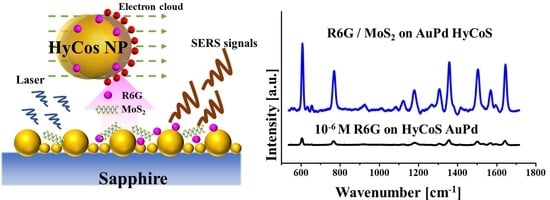MoS2 Nanoplatelets on Hybrid Core-Shell (HyCoS) AuPd NPs for Hybrid SERS Platform for Detection of R6G
Abstract
:1. Introduction
2. Fabrication of Hybrid Core-Shell (HyCoS) AuPd NPs
Optical Characterization of HyCoS AuPd NPs
3. SERS Analyses of Rhodamine 6G on Various Substrates
SERS Enhancement Factor (EF) and Enhancement Mechanism
4. Conclusions
Supplementary Materials
Author Contributions
Funding
Institutional Review Board Statement
Informed Consent Statement
Data Availability Statement
Conflicts of Interest
References
- Guselnikova, O.; Lim, H.; Kim, H.-J.; Kim, S.H.; Gorbunova, A.; Eguchi, M.; Postnikov, P.; Nakanishi, T.; Asahi, T.; Na, J.; et al. New Trends in Nanoarchitectured SERS Substrates: Nanospaces, 2D Materials, and Organic Heterostructures. Small 2022, 18, 2107182. [Google Scholar] [CrossRef]
- Zhang, M.; Guo, X. Gold/platinum bimetallic nanomaterials for immunoassay and immunosensing. Coord. Chem. Rev. 2022, 465, 214578. [Google Scholar] [CrossRef]
- Spedalieri, C.; Kneipp, J. Surface enhanced Raman scattering for probing cellular biochemistry. Nanoscale 2022, 14, 5314–5328. [Google Scholar] [CrossRef]
- Norton, R.D.; Phan, H.T.; Gibbons, S.N.; Haes, A.J. Quantitative Surface-Enhanced Spectroscopy. Annu. Rev. Phys. Chem. 2022, 73, 141–162. [Google Scholar] [CrossRef]
- Visaveliya, N.R.; Mazetyte-Stasinskiene, R.; Köhler, J.M. Stationary, Continuous, and Sequential Surface-Enhanced Raman Scattering Sensing Based on the Nanoscale and Microscale Polymer-Metal Composite Sensor Particles through Microfluidics: A Review. Adv. Opt. Mater. 2022, 10, 2102757. [Google Scholar] [CrossRef]
- Li, C.; Xu, S.; Yu, J.; Li, Z.; Li, W.; Wang, J.; Liu, A.; Man, B.; Yang, S.; Zhang, C. Local hot charge density regulation: Vibration-free pyroelectric nanogenerator for effectively enhancing catalysis and in-situ surface enhanced Raman scattering monitoring. Nano Energy 2021, 81, 105585. [Google Scholar] [CrossRef]
- Mandavkar, R.; Lin, S.; Kulkarni, R.; Pandit, S.; Burse, S.; Habib, M.A.; Pandey, P.; Kunwar, S.; Lee, J. Dual-step hybrid SERS scheme through the blending of CV and MoS2 NPs on the AuPt core-shell hybrid NPs. J. Mater. Sci. Technol. 2022, 107, 1–13. [Google Scholar] [CrossRef]
- Pandit, S.; Kunwar, S.; Kulkarni, R.; Mandavka, R.; Lin, S.; Lee, J. Fabrication of hybrid Pd@Ag core-shell and fully alloyed bi-metallic AgPd NPs and SERS enhancement of Rhodamine 6G by a unique mixture approach with graphene quantum dots. Appl. Surf. Sci. 2021, 548, 149252. [Google Scholar] [CrossRef]
- Kaur, G.; Tanwar, S.; Kaur, V.; Biswas, R.; Saini, S.; Haldar, K.K.; Sen, T. Interfacial design of gold/silver core–shell nanostars for plasmon-enhanced photocatalytic coupling of 4-aminothiophenol. J. Mater. Chem. C 2021, 9, 15284–15294. [Google Scholar] [CrossRef]
- Mandavkar, R.; Lin, S.; Kulkarni, R.; Burse, S.; Habib, M.A.; Kunwar, S.; Lee, J. Dual-step photocarrier injection by mixture layer of ZnO QDs and MoS2 NPs on hybrid PdAu NPs. Mater. Res. Bull. 2022, 151, 111832. [Google Scholar] [CrossRef]
- Liu, D.; Yi, W.; Fu, Y.; Kong, Q.; Xi, G. In Situ Surface Restraint-Induced Synthesis of Transition-Metal Nitride Ultrathin Nanocrystals as Ultrasensitive SERS Substrate with Ultrahigh Durability. ACS Nano 2022, 16, 13123–13133. [Google Scholar] [CrossRef]
- Lin, S.; Habib, M.A.; Burse, S.; Mandavkar, R.; Khalid, T.; Joni, M.H.; Li, M.-Y.; Kunwar, S.; Lee, J. Hybrid UV Photodetector Design Incorporating AuPt Alloy Hybrid Nanoparticles, ZnO Quantum Dots, and Graphene Quantum Dots. ACS Appl. Mater. Interfaces 2022, 15, 2204–2215. [Google Scholar] [CrossRef]
- Lee, S.; Jung, I.; Son, J.; Lee, S.; Park, M.; Kim, J.-E.; Park, W.; Lee, J.; Nam, J.-M.; Park, S. Heterogeneous Component Au (Outer)–Pt (Middle)–Au (Inner) Nanorings: Synthesis and Vibrational Characterization on Middle Pt Nanorings with Surface-Enhanced Raman Scattering. ACS Nano 2022, 16, 11259–11267. [Google Scholar] [CrossRef]
- Jin, J.; Song, W.; Wang, J.; Li, L.; Tian, Y.; Zhu, S.; Zhang, Y.; Xu, S.; Yang, B.; Zhao, B. A highly sensitive SERS platform based on small-sized Ag/GQDs nanozyme for intracellular analysis. Chem. Eng. J. 2022, 430, 132687. [Google Scholar] [CrossRef]
- Zhai, J.; Li, X.; Zhang, J.; Pan, H.; Peng, Q.; Gan, H.; Su, S.; Yuwen, L.; Song, C. SERS/electrochemical dual-mode biosensor based on multi-functionalized molybdenum disulfide nanosheet probes and SERS-active Ag nanorods array electrodes for reliable detection of cancer-related miRNA. Sensors Actuators B Chem. 2022, 368, 132245. [Google Scholar] [CrossRef]
- Mandavkar, R.; Lin, S.; Pandit, S.; Kulkarni, R.; Burse, S.; Habib, M.A.; Kunwar, S.; Lee, J. Hybrid SERS platform by adapting both chemical mechanism and electromagnetic mechanism enhancements: SERS of 4-ATP and CV by the mixture with GQDs on hybrid PdAg NPs. Surf. Interfaces 2022, 33, 102175. [Google Scholar] [CrossRef]
- Wang, L.; Patskovsky, S.; Gauthier-Soumis, B.; Meunier, M. Porous Au–Ag Nanoparticles from Galvanic Replacement Applied as Single-Particle SERS Probe for Quantitative Monitoring. Small 2022, 18, 2105209. [Google Scholar] [CrossRef]
- Barveen, N.R.; Wang, T.-J.; Chang, Y.-H. A photochemical approach to anchor Au NPs on MXene as a prominent SERS substrate for ultrasensitive detection of chlorpromazine. Microchim. Acta 2021, 189, 16. [Google Scholar] [CrossRef]
- Mandavkar, R.; Kulkarni, R.; Lin, S.; Pandit, S.; Burse, S.; Ahasan Habib, M.; Pandey, P.; Hee Kim, S.; Li, M.-Y.; Kunwar, S.; et al. Significantly improved photo carrier injection by the MoS2/ZnO/HNP hybrid UV photodetector architecture. Appl. Surf. Sci. 2022, 574, 151739. [Google Scholar] [CrossRef]
- Lin, S.; Kulkarni, R.; Mandavkar, R.; Habib, M.A.; Burse, S.; Kunwar, S.; Lee, J. Surmounting the interband threshold limit by the hot electron excitation of multi-metallic plasmonic AgAuCu NPs for UV photodetector application. CrystEngComm 2022, 24, 4134–4143. [Google Scholar] [CrossRef]
- Wei, J.; Zhang, Y.-J.; Qin, S.-N.; Yang, W.-M.; Zhang, H.; Yang, Z.-L.; Tian, Z.-Q.; Li, J.-F. Understanding the strain effect of Au@Pd nanocatalysts by in situ surface-enhanced Raman spectroscopy. Chem. Commun. 2019, 55, 8824–8827. [Google Scholar] [CrossRef]
- Kaushik, V.; Kagdada, H.L.; Singh, D.K.; Pathak, S. Enhancement of SERS effect in Graphene-Silver hybrids. Appl. Surf. Sci. 2022, 574, 151724. [Google Scholar] [CrossRef]
- Mousavi, S.M.; Hashemi, S.A.; Yari Kalashgrani, M.; Kurniawan, D.; Gholami, A.; Rahmanian, V.; Omidifar, N.; Chiang, W.-H. Recent Advances in Inflammatory Diagnosis with Graphene Quantum Dots Enhanced SERS Detection. Biosensors 2022, 12, 461. [Google Scholar] [CrossRef]
- Samriti; Rajput, V.; Gupta, R.K.; Prakash, J. Engineering metal oxide semiconductor nanostructures for enhanced charge transfer: Fundamentals and emerging SERS applications. J. Mater. Chem. C 2022, 10, 73–95. [Google Scholar] [CrossRef]
- Man, B.; Wang, G.; Li, Z.; Xu, S.; Li, C.; Yu, J.; Zhang, C.; Zhao, X. MoS2-spaced bimetal composite structure as SERS-SPR sensor for glucose detection. J. Alloy. Compd. 2022, 902, 163789. [Google Scholar] [CrossRef]
- Zhang, Z.; Yu, J.; Yang, J.; Lv, X.; Wang, T. Preparation of sensitive and recyclable porous Ag/TiO2 composite films for SERS detection. Appl. Surf. Sci. 2015, 359, 853–859. [Google Scholar] [CrossRef]
- Singh, J.; Rishikesh; Kumar, S.; Soni, R.K. Synthesis of 3D-MoS2 nanoflowers with tunable surface area for the application in photocatalysis and SERS based sensing. J. Alloy. Compd. 2020, 849, 156502. [Google Scholar] [CrossRef]
- Zuo, P.; Jiang, L.; Li, X.; Li, B.; Ran, P.; Li, X.; Qu, L.; Lu, Y. Metal (Ag, Pt)-MoS2 Hybrids Greenly Prepared Through Photochemical Reduction of Femtosecond Laser Pulses for SERS and HER. ACS Sustain. Chem. Eng. 2018, 6, 7704–7714. [Google Scholar] [CrossRef]
- Er, E.; Sánchez-Iglesias, A.; Silvestri, A.; Arnaiz, B.; Liz-Marzán, L.M.; Prato, M.; Criado, A. Metal Nanoparticles/MoS2 Surface-Enhanced Raman Scattering-Based Sandwich Immunoassay for α-Fetoprotein Detection. ACS Appl. Mater. Interfaces 2021, 13, 8823–8831. [Google Scholar] [CrossRef]
- Quan, Y.; Li, J.; Hu, M.; Wei, M.; Yang, J.; Gao, M.; Liu, Y. Interface synthesis of MoS2@ZnO@Ag SERS substrate for the ultrasensitive determination of bilirubin. Appl. Surf. Sci. 2022, 598, 153750. [Google Scholar] [CrossRef]
- Yang, S.; Xu, F.; Ostendorp, S.; Wilde, G.; Zhao, H.; Lei, Y. Template-Confined Dewetting Process to Surface Nanopatterns: Fabrication, Structural Tunability, and Structure-Related Properties. Adv. Funct. Mater. 2011, 21, 2446–2455. [Google Scholar] [CrossRef]
- Sharipova, A.; Klinger, L.; Bisht, A.; Straumal, B.B.; Rabkin, E. Solid-state dewetting of thin Au films on oxidized surface of biomedical TiAlV alloy. Acta Mater. 2022, 231, 117919. [Google Scholar] [CrossRef]
- Kunwar, S.; Pandit, S.; Kulkarni, R.; Mandavkar, R.; Lin, S.; Li, M.Y.; Lee, J. Hybrid device architecture using plasmonic nanoparticles, graphene quantum dots, and titanium dioxide for UV photodetectors. ACS Appl. Mater. Interfaces 2021, 13, 3408–3418. [Google Scholar] [CrossRef]
- McArdle, P.; Erxleben, A. Sublimation—A green route to new solid-state forms. CrystEngComm 2021, 23, 5965–5975. [Google Scholar] [CrossRef]
- Vieira, F.M.; Gabriela Calisto, C.M.; Izumi, C. Construction of SERS substrates by gold nanoparticles assembly on polymeric matrices. Appl. Surf. Sci. 2023, 612, 155818. [Google Scholar] [CrossRef]
- De Marchi, S.; Núñez-Sánchez, S.; Bodelón, G.; Pérez-Juste, J.; Pastoriza-Santos, I. Pd nanoparticles as a plasmonic material: Synthesis, optical properties and applications. Nanoscale 2020, 12, 23424–23443. [Google Scholar] [CrossRef]
- Jain, P.K.; Lee, K.S.; El-Sayed, I.H.; El-Sayed, M.A. Calculated Absorption and Scattering Properties of Gold Nanoparticles of Different Size, Shape, and Composition: Applications in Biological Imaging and Biomedicine. J. Phys. Chem. B 2006, 110, 7238–7248. [Google Scholar] [CrossRef] [Green Version]
- Matsui, H.; Shoji, M.; Higano, S.; Yoda, H.; Ono, Y.; Yang, J.; Misumi, T.; Fujita, A. Infrared Plasmonic Metamaterials Based on Transparent Nanoparticle Films of In2O3:Sn for Solar-Thermal Shielding Applications. ACS Appl. Mater. Interfaces 2022, 14, 49313–49325. [Google Scholar] [CrossRef]
- Er, E.; Hou, H.-L.; Criado, A.; Langer, J.; Möller, M.; Erk, N.; Liz-Marzán, L.M.; Prato, M. High-Yield Preparation of Exfoliated 1T-MoS2 with SERS Activity. Chem. Mater. 2019, 31, 5725–5734. [Google Scholar] [CrossRef] [Green Version]
- Su, S.; Zhang, C.; Yuwen, L.; Chao, J.; Zuo, X.; Liu, X.; Song, C.; Fan, C.; Wang, L. Creating SERS Hot Spots on MoS2 Nanosheets with in Situ Grown Gold Nanoparticles. ACS Appl. Mater. Interfaces 2014, 6, 18735–18741. [Google Scholar] [CrossRef]
- Yoo, S.S.; Ho, J.-W.; Shin, D.-I.; Kim, M.; Hong, S.; Lee, J.H.; Jeong, H.J.; Jeong, M.S.; Yi, G.-R.; Kwon, S.J.; et al. Simultaneously intensified plasmonic and charge transfer effects in surface enhanced Raman scattering sensors using an MXene-blanketed Au nanoparticle assembly. J. Mater. Chem. A 2022, 10, 2945–2956. [Google Scholar] [CrossRef]
- Korolkov, I.V.; Shumskaya, A.; Kozlovskiy, A.L.; Kaliyekperov, M.E.; Lissovskaya, L.I.; Zdorovets, M. V Magnetic-plasmonic Ni nanotubes covered with gold for improvement of SERS analysis. J. Alloy. Compd. 2022, 901, 163661. [Google Scholar] [CrossRef]
- Dieringer, J.A.; Wustholz, K.L.; Masiello, D.J.; Camden, J.P.; Kleinman, S.L.; Schatz, G.C.; Van Duyne, R.P. Surface-enhanced Raman excitation spectroscopy of a single rhodamine 6G molecule. J. Am. Chem. Soc. 2009, 131, 849–854. [Google Scholar] [CrossRef]
- Kim, W.; Bang, A.; Kim, S.; Lee, G.-J.; Kim, Y.-H.; Choi, S. Adiponectin-targeted SERS immunoassay biosensing platform for early detection of gestational diabetes mellitus. Biosens. Bioelectron. 2022, 213, 114488. [Google Scholar] [CrossRef]
- Li, X.; Choy, W.C.H.; Ren, X.; Zhang, D.; Lu, H. Highly Intensified Surface Enhanced Raman Scattering by Using Monolayer Graphene as the Nanospacer of Metal Film–Metal Nanoparticle Coupling System. Adv. Funct. Mater. 2014, 24, 3114–3122. [Google Scholar] [CrossRef]
- Ansar, S.M.; Li, X.; Zou, S.; Zhang, D. Quantitative Comparison of Raman Activities, SERS Activities, and SERS Enhancement Factors of Organothiols: Implication to Chemical Enhancement. J. Phys. Chem. Lett. 2012, 3, 560–565. [Google Scholar] [CrossRef]
- Jia, M.; Cheng, C.; Cui, L.; Li, Y.; Jin, X.-J. The effects of deposition time and current density on the electrochemical performance of flexible and high-performance MnO2@PFG composite electrodes. RSC Adv. 2020, 10, 3544–3553. [Google Scholar] [CrossRef] [Green Version]
- Long, G.L.; Winefordner, J.D. Limit of Detection A Closer Look at the IUPAC Definition. Anal. Chem. 1983, 55, 712A–724A. [Google Scholar] [CrossRef]
- Seo, J.; Kim, Y.; Lee, J.; Son, E.; Jung, M.-H.; Kim, Y.-M.; Jeong, H.Y.; Lee, G.; Park, H. A single-atom vanadium-doped 2D semiconductor platform for attomolar-level molecular sensing. J. Mater. Chem. A 2022, 10, 13298–13304. [Google Scholar] [CrossRef]
- Ko, T.-S.; Chen, Y.-L. Hybrid Enhancement of Surface-Enhanced Raman Scattering Using Few-Layer MoS2 Decorated with Au Nanoparticles on Si Nanosquare Holes. Nanomaterials 2022, 12, 786. [Google Scholar] [CrossRef]
- Quan, Y.; Yao, J.; Yang, S.; Chen, L.; Li, J.; Liu, Y.; Lang, J.; Shen, H.; Wang, Y.; Wang, Y.; et al. ZnO nanoparticles on MoS2 microflowers for ultrasensitive SERS detection of bisphenol A. Microchim. Acta 2019, 186, 593. [Google Scholar] [CrossRef]
- Kannan, P.K.; Shankar, P.; Blackman, C.; Chung, C.-H. Recent Advances in 2D Inorganic Nanomaterials for SERS Sensing. Adv. Mater. 2019, 31, 1803432. [Google Scholar] [CrossRef] [Green Version]
- Tegegne, W.A.; Su, W.-N.; Tsai, M.-C.; Beyene, A.B.; Hwang, B.-J. Ag nanocubes decorated 1T-MoS2 nanosheets SERS substrate for reliable and ultrasensitive detection of pesticides. Appl. Mater. Today 2020, 21, 100871. [Google Scholar] [CrossRef]
- Sun, H.; Yao, M.; Liu, S.; Song, Y.; Shen, F.; Dong, J.; Yao, Z.; Zhao, B.; Liu, B. SERS Selective Enhancement on Monolayer MoS2 Enabled by a Pressure-Induced Shift from Resonance to Charge Transfer. ACS Appl. Mater. Interfaces 2021, 13, 26551–26560. [Google Scholar] [CrossRef]
- Liang, L.; Meunier, V. First-Principles Raman Spectra of MoS2, WS2 and Their Heterostructures. Nanoscale 2014, 6, 5394–5401. [Google Scholar] [CrossRef]
- Palik, E.D. Handbook of Optical Constants of Solids; Academic Press: Cambridge, MA, USA, 1998; Volume 3, ISBN 0125444230. [Google Scholar]
- Palm, K.J.; Murray, J.B.; Narayan, T.C.; Munday, J.N. Dynamic Optical Properties of Metal Hydrides. ACS Photonics 2018, 5, 4677–4686. [Google Scholar] [CrossRef] [Green Version]
- Sui, M.; Kunwar, S.; Pandey, P.; Lee, J. Strongly Confined Localized Surface Plasmon Resonance (LSPR) Bands of Pt, AgPt, AgAuPt Nanoparticles. Sci. Rep. 2019, 9, 1–14. [Google Scholar] [CrossRef] [Green Version]
- Wu, T.; Zheng, H.; Kou, Y.; Su, X.; Kadasala, N.R.; Gao, M.; Chen, L.; Han, D.; Liu, Y.; Yang, J. Self-Sustainable and Recyclable Ternary Au@Cu2O–Ag Nanocomposites: Application in Ultrasensitive SERS Detection and Highly Efficient Photocatalysis of Organic Dyes under Visible Light. Microsystems Nanoeng. 2021, 7, 23. [Google Scholar] [CrossRef]
- Capaccio, A.; Sasso, A.; Rusciano, G. Feasibility of SERS-Active Porous Ag Substrates for the Effective Detection of Pyrene in Water. Sensors 2022, 22, 2764. [Google Scholar] [CrossRef]
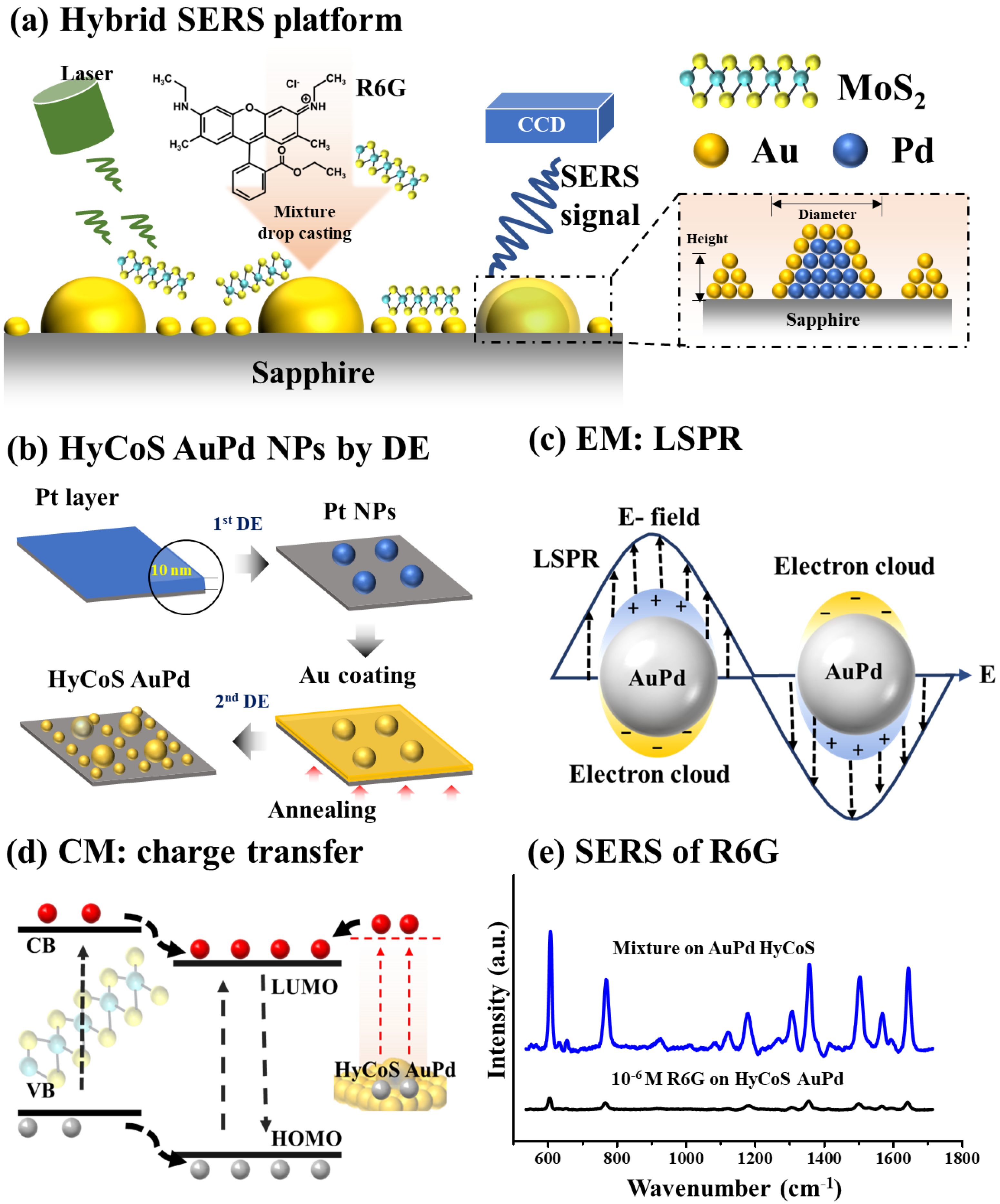
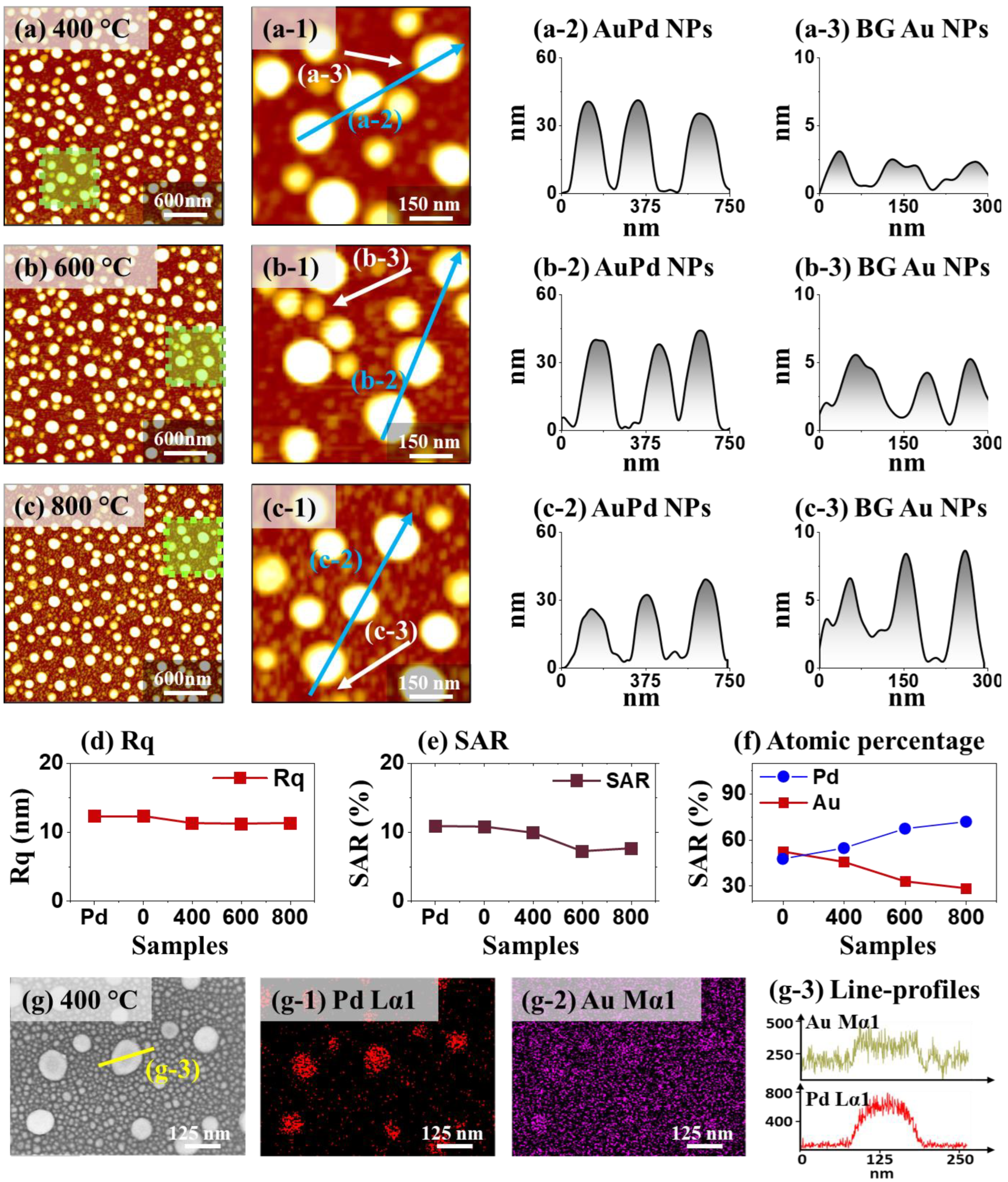
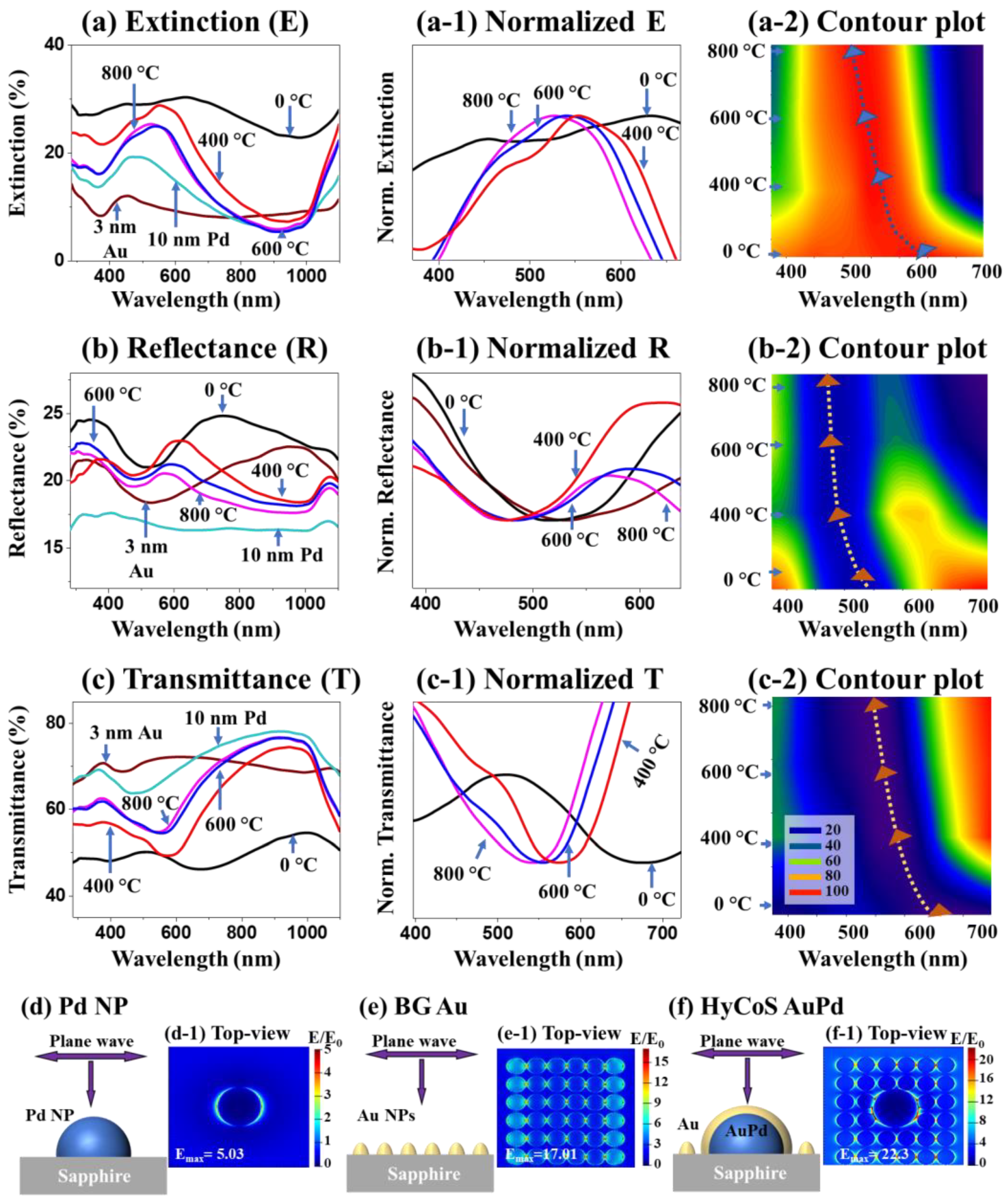
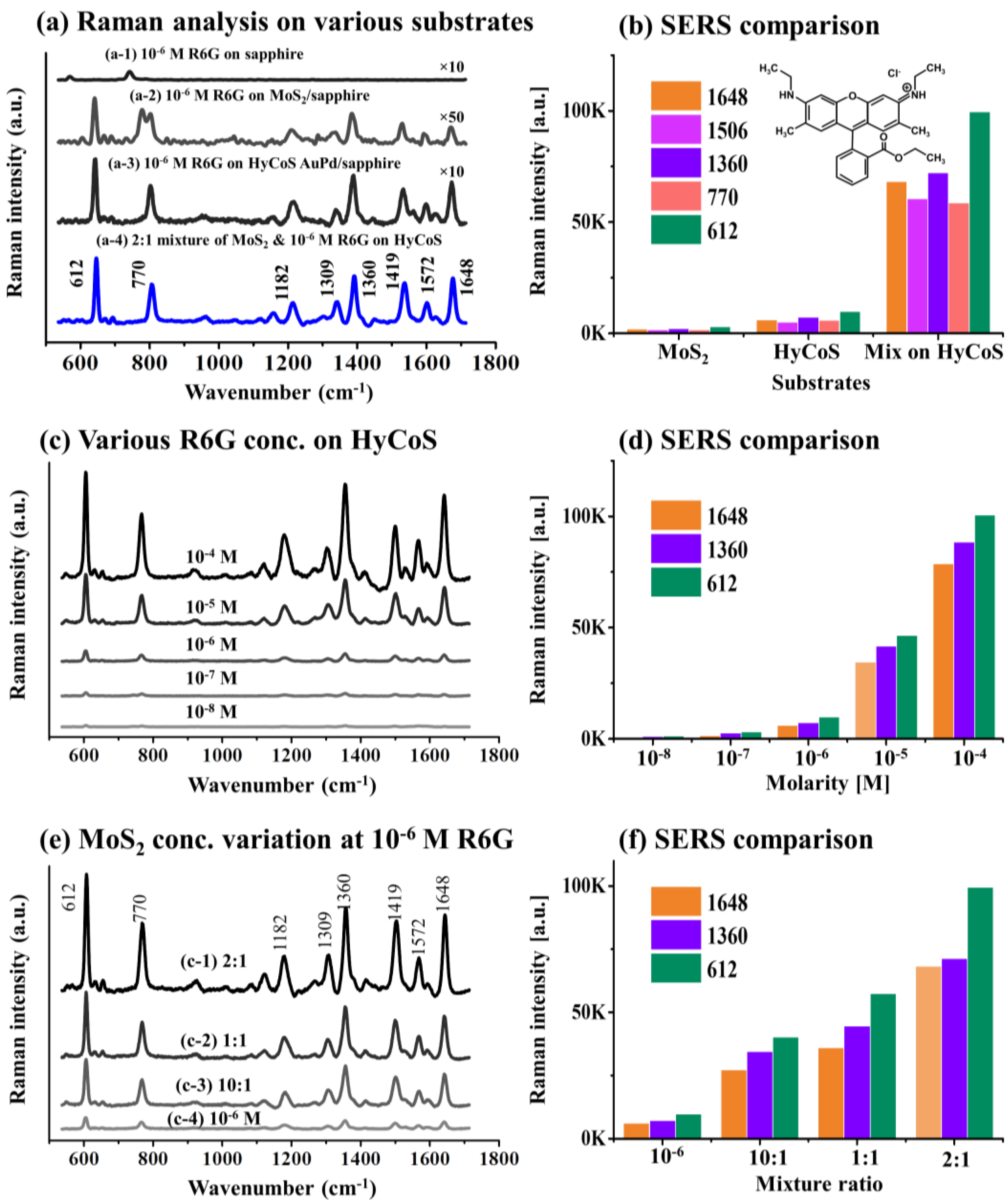
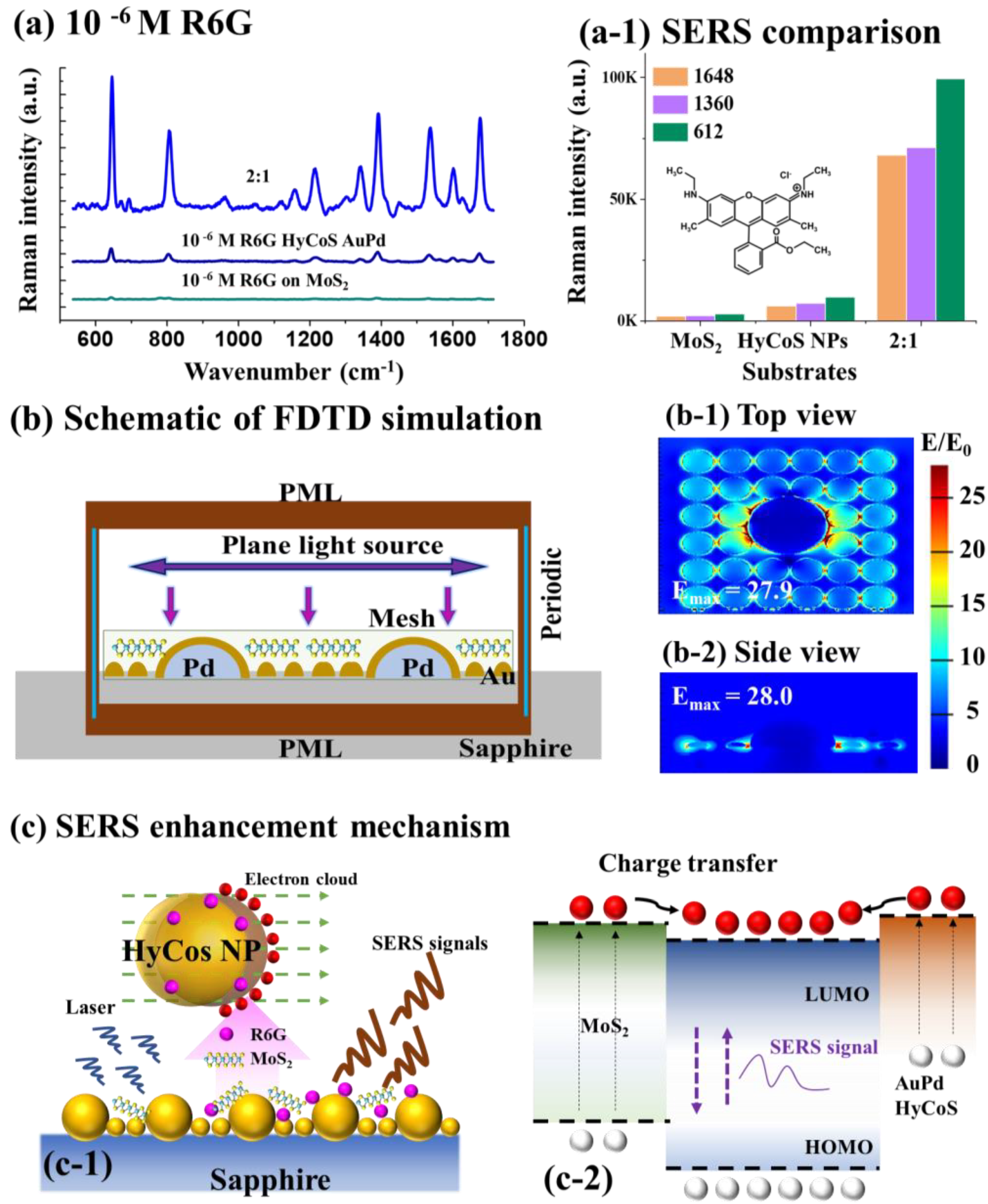
Disclaimer/Publisher’s Note: The statements, opinions and data contained in all publications are solely those of the individual author(s) and contributor(s) and not of MDPI and/or the editor(s). MDPI and/or the editor(s) disclaim responsibility for any injury to people or property resulting from any ideas, methods, instructions or products referred to in the content. |
© 2023 by the authors. Licensee MDPI, Basel, Switzerland. This article is an open access article distributed under the terms and conditions of the Creative Commons Attribution (CC BY) license (https://creativecommons.org/licenses/by/4.0/).
Share and Cite
Lin, S.; Mandavkar, R.; Burse, S.; Habib, M.A.; Khalid, T.; Joni, M.H.; Chung, Y.-U.; Kunwar, S.; Lee, J. MoS2 Nanoplatelets on Hybrid Core-Shell (HyCoS) AuPd NPs for Hybrid SERS Platform for Detection of R6G. Nanomaterials 2023, 13, 769. https://doi.org/10.3390/nano13040769
Lin S, Mandavkar R, Burse S, Habib MA, Khalid T, Joni MH, Chung Y-U, Kunwar S, Lee J. MoS2 Nanoplatelets on Hybrid Core-Shell (HyCoS) AuPd NPs for Hybrid SERS Platform for Detection of R6G. Nanomaterials. 2023; 13(4):769. https://doi.org/10.3390/nano13040769
Chicago/Turabian StyleLin, Shusen, Rutuja Mandavkar, Shalmali Burse, Md Ahasan Habib, Tasmia Khalid, Mehedi Hasan Joni, Young-Uk Chung, Sundar Kunwar, and Jihoon Lee. 2023. "MoS2 Nanoplatelets on Hybrid Core-Shell (HyCoS) AuPd NPs for Hybrid SERS Platform for Detection of R6G" Nanomaterials 13, no. 4: 769. https://doi.org/10.3390/nano13040769
APA StyleLin, S., Mandavkar, R., Burse, S., Habib, M. A., Khalid, T., Joni, M. H., Chung, Y.-U., Kunwar, S., & Lee, J. (2023). MoS2 Nanoplatelets on Hybrid Core-Shell (HyCoS) AuPd NPs for Hybrid SERS Platform for Detection of R6G. Nanomaterials, 13(4), 769. https://doi.org/10.3390/nano13040769








